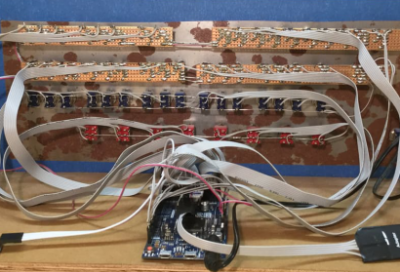Browse around eBay for an original Altair 8800 and you quickly find that the price range is in the thousands of dollars. If you are a collector and have some money in your pocket maybe that’s okay. But if you want the Altair 8800 experience on a budget, you can build yourself a clone with an Arduino. [David] kindly shared the build details on his Arduino Project Hub post. Using an Arduino Due (or a Mega for 25% of original speed), the clone can accurately reproduce the behavior of the Altair’s front panel elements. We covered a similar project in the past, using the Arduino Uno.
While not overly complicated to build one, you will need a  fair amount of patience so you can solder all the 36 LEDs, switches, transistors, and resistors but in the end, you’ll end up with a brand new computer to play with. In 1975, an assembled Altair 8800 Computer was selling for $621 and $439 for an unassembled version. Sourced right, your clone would be under 50 bucks. Not bad.
fair amount of patience so you can solder all the 36 LEDs, switches, transistors, and resistors but in the end, you’ll end up with a brand new computer to play with. In 1975, an assembled Altair 8800 Computer was selling for $621 and $439 for an unassembled version. Sourced right, your clone would be under 50 bucks. Not bad.
The simulator comes with a bunch of software for you to try out and even games like Kill-the-Bit and Pong. BASIC and Assembler example programs are included in the emulator software and can easily be loaded.
In addition, the simulator includes some extra functions and built-in software for the Altair which are accessible via the AUX1/AUX2 switches on the front panel (those were included but not used on the original Altair). From starting different games to mount disks in an emulated disk drive, there are just too many functions to describe here. You can take a look at the simulator documentation for more information.
In case you don’t know already, here’s how to play Kill-the-Bit:
















Actually, Bill is probably not OK with people using his BASIC interpreter without paying for it. I hear he needs the money.
I played with an 8800B for a couple of hours once using the front panel only. That was quite enough.
Makes one sympathize for those before then.
Boy does this bring back memories. The college where I started teaching had an 8800B. They’d just bought a 32KB board with BASIC onboard for it. A cool $1000 in 1979 dollars.
It had to be done!
Help! We’re being attacked by zombie computers!!!
I remember this one being on the front cover of an electronics magazine in the mid to late 70’s? From memory the original had big lever toggle switches.
It must be more than it looks by the width of the address bus.
It’s a nice build. I am surprised that it runs at a quarter speed with a 20 MIPs chip but that’s because it’s coded in C.
There must be other simple computers like this waiting to be re-made with modern electronics.
I have a KIM-1 clone that runs on an Arduino mini or pro.
I had two of them back in the day and loved both of them. I had the 8800b with the full front panel and a couple of floppy drives, and then later got the “turnkey” version that was built into the desk with the Pertec 5MB hard drive. That hard drive was extremely loud. It sounded practically like a jet airplane taking off. I eventually upgraded both of them to Z80’s, albeit with no front-panel control, and ran CP/M on them. And those were my “personal computers” until the PC came along.
5MB must have been huge back then! What were floppy drives in capacity … 180kB?
I remember the firsts Seagate drives on the PC that were about 20MB with a MFM controller or 30MB with a RLL controller but that was in the early 80’s.
I am guessing that the CPU of the 8800 was discrete chips because the ‘status’ register is displayed on the front panel and you can’t do that with a one chip CPU ??
It is interesting to note that $621 in 1975 is the same as $2,785.88 in 2017. So if you can score an original Altair for around that it has not appreciated in value at all. If it has any extra memory or other boards in it, it should we worth a lot more.
A friend of mine was a concert pianist. He would program his Altair using the front panel switches in chords. 10 fingers could push up to 10 switches up. 10 fingers could push up to 10 switches down. He would repeat these motions at a blinding speed until the bootloader was ready to read the paper tape that loaded the program to talk to the ASR33 terminal.
Those were the good old days! I think I can do without them…
I fried of mine has a TRS-80 when we were in high school. I told him I’d buy a computer when they dropped to $100, two year later I bought a ZX-81 kit for $99 (later bought a Memotek 32K module). You know you suck at chess when an 8-bit computer (with a program that required 16k) will kick your butt.
What no Lear Sigler?
I’m still mad at myself for getting rid of an old Data General front panel. It had one broken switch lever, which at the time I figured I’d never find a replacement. Then 3d printing happened. Now I feel like Dr McCoy.
Still waiting for someone to build a Kaypro 4 simulator. Now, that was a computer you could actually use for something.
Jack